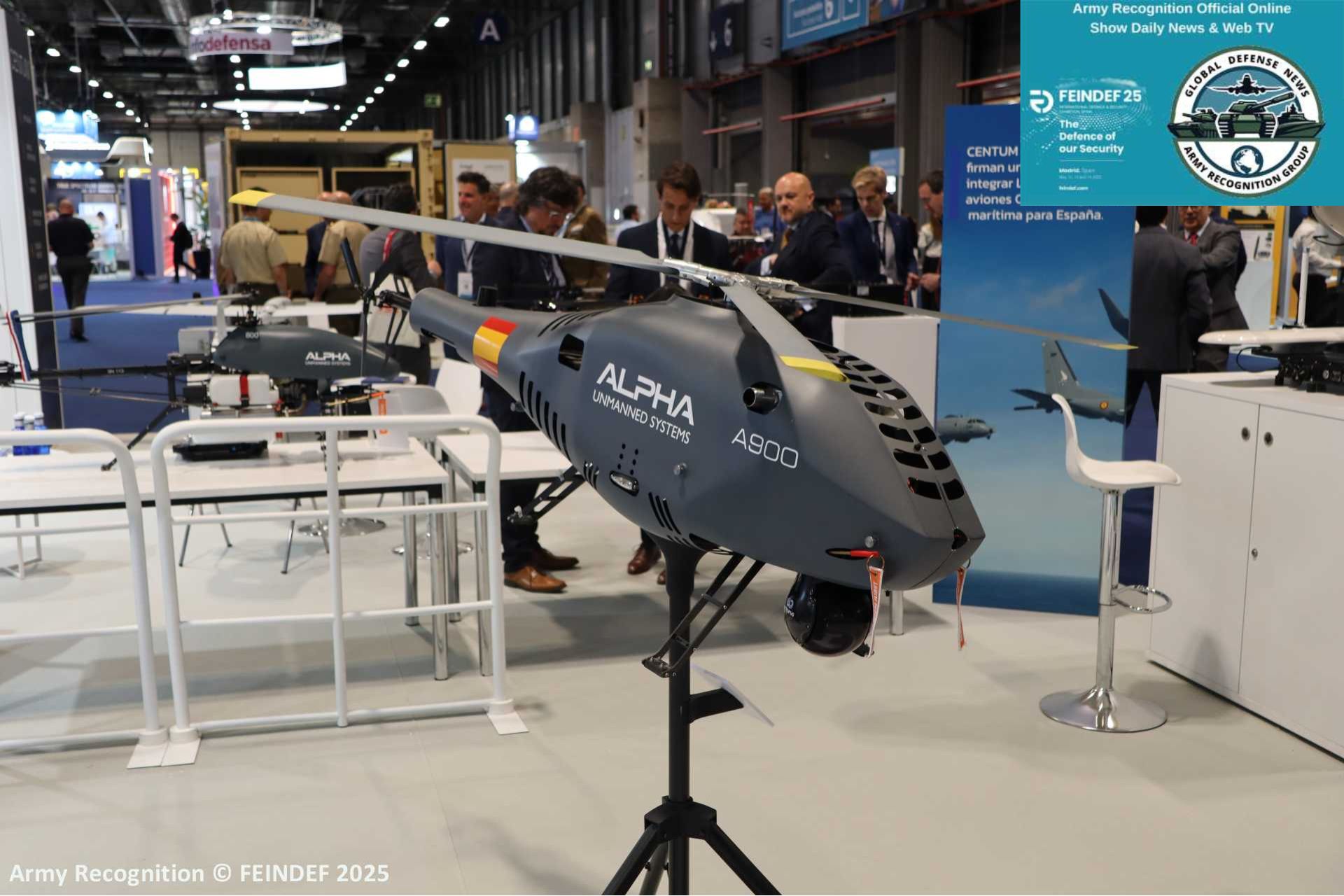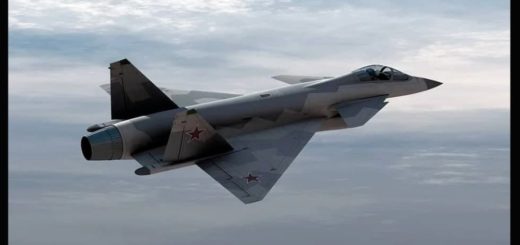FEINDEF 2025: Spanish Tactical A900 Helicopter Drone Draws Interest from US Department of Defense

{loadposition bannertop}
{loadposition sidebarpub}
At the 2025 edition of the FEINDEF exhibition in Madrid, Spanish company Alpha Unmanned Systems presents its A900 tactical drone, a rotary-wing unmanned aerial vehicle with vertical take-off and landing (VTOL) capability designed for a wide range of missions, including maritime surveillance, ISR operations, infrastructure inspection, and target simulation. Developed to meet the requirements of military forces and security agencies, the A900 is characterized by its modularity, durability, and extended autonomy, enabling day and night operations.
Follow Army Recognition on Google News at this link
With a minimal logistical footprint and a landing radius of just three meters, the A900 can autonomously take off and land from moving vessels, even under challenging sea conditions (Picture source: Army Recognition)
The A900 has a wingspan of 2.07 meters and a length of 1.76 meters, with a maximum take-off weight of less than 25 kilograms. It is powered by a 100cc two-stroke boxer engine operating on heavy fuel (Jet A1, JP8, or 98-octane gasoline) and features an onboard generator capable of supplying up to 150 watts for energy-demanding payloads. The system offers up to four hours of flight endurance and can maintain autonomous hovering for over two and a half hours. Its maximum speed is 100 km/h, with a typical cruising speed of 60 km/h, and it can reach an operational ceiling of 3,000 meters.
With a minimal logistical footprint and a landing radius of just three meters, the A900 can autonomously take off and land from moving vessels, even under challenging sea conditions (up to sea state 5 and inclinations of 10°). It is equipped with a radar altimeter, emergency flotation devices, autorotation capability, and systems designed for operation in GPS-denied environments. Communications are secured via encrypted links.
The drone includes four distinct payload bays (main, secondary, anchor points, and electrical), supporting a total payload of up to 4 kilograms. It is compatible with a wide range of sensors and equipment, including electro-optical and infrared cameras, LiDAR systems, AIS transponders, IMSI catchers, and cargo release mechanisms. Depending on the configuration, the A900 offers a radio range of up to 100 km and a maximum operational range of 200 km.
The A900 has recently undergone operational evaluation in a real-world setting. In May 2024, Alpha Unmanned Systems announces a collaboration with Rapid Expeditionary Concepts in southern Spain as part of a test campaign conducted for the United States Department of Defense. The initiative focuses on integrating an advanced electro-optical sensor onto the drone for continuous surveillance and border monitoring missions. During trials in Jaén Province, the A900 demonstrates its ability to perform persistent monitoring at 1,000 meters altitude, dividing the area into nine segments and detecting changes in near real-time. This approach supports early threat identification and prompt intervention in sensitive zones.
This cooperation reflects growing interest from armed forces in lightweight, modular, and autonomous systems capable of operating in complex environments. In addition to the U.S. Department of Defense, Alpha Unmanned Systems’ clients and partners include the Indonesian Coast Guard, the Hellenic Navy, the Spanish Ministry of Defense, and Spain’s National Institute for Aerospace Technology (INTA). In Indonesia, the A900 is deployed for maritime monitoring through a local assembly partnership with PT. Global Defense and PT. MS.Tech, providing a cost-effective alternative to conventional shipborne helicopters.
Compliant with NATO standard STANAG 4738 and manufactured under ISO9001 certification, the A900 integrates critical components such as an autopilot tested according to MIL-STD 416F and 810F, and servos meeting EN61000 and IP64 standards. These systems have a calculated mean time between failures (MTBF) exceeding 1,000 hours, based on Weibull analysis and endurance testing up to 3,000 hours. Alpha Unmanned Systems ensures its platforms align with the requirements of the European Union Aviation Safety Agency (EASA) for both civil and military certification.
Founded in Spain in 2014, Alpha Unmanned Systems specializes in the development of tactical rotary UAVs for demanding missions. The presentation of the A900 at FEINDEF 2025 underscores the company’s objective to deliver a certifiable, modular platform tailored for national and international security operators. Designed to integrate into naval and land-based ISR networks, the system has the potential to serve as a critical asset in modern surveillance operations. With its multipurpose capabilities, suitability for harsh environments, and growing operational footprint, the A900 is positioned for increased adoption among military forces and civil institutions across multiple continents.

{loadposition bannertop}
{loadposition sidebarpub}
At the 2025 edition of the FEINDEF exhibition in Madrid, Spanish company Alpha Unmanned Systems presents its A900 tactical drone, a rotary-wing unmanned aerial vehicle with vertical take-off and landing (VTOL) capability designed for a wide range of missions, including maritime surveillance, ISR operations, infrastructure inspection, and target simulation. Developed to meet the requirements of military forces and security agencies, the A900 is characterized by its modularity, durability, and extended autonomy, enabling day and night operations.
With a minimal logistical footprint and a landing radius of just three meters, the A900 can autonomously take off and land from moving vessels, even under challenging sea conditions (Picture source: Army Recognition)
The A900 has a wingspan of 2.07 meters and a length of 1.76 meters, with a maximum take-off weight of less than 25 kilograms. It is powered by a 100cc two-stroke boxer engine operating on heavy fuel (Jet A1, JP8, or 98-octane gasoline) and features an onboard generator capable of supplying up to 150 watts for energy-demanding payloads. The system offers up to four hours of flight endurance and can maintain autonomous hovering for over two and a half hours. Its maximum speed is 100 km/h, with a typical cruising speed of 60 km/h, and it can reach an operational ceiling of 3,000 meters.
With a minimal logistical footprint and a landing radius of just three meters, the A900 can autonomously take off and land from moving vessels, even under challenging sea conditions (up to sea state 5 and inclinations of 10°). It is equipped with a radar altimeter, emergency flotation devices, autorotation capability, and systems designed for operation in GPS-denied environments. Communications are secured via encrypted links.
The drone includes four distinct payload bays (main, secondary, anchor points, and electrical), supporting a total payload of up to 4 kilograms. It is compatible with a wide range of sensors and equipment, including electro-optical and infrared cameras, LiDAR systems, AIS transponders, IMSI catchers, and cargo release mechanisms. Depending on the configuration, the A900 offers a radio range of up to 100 km and a maximum operational range of 200 km.
The A900 has recently undergone operational evaluation in a real-world setting. In May 2024, Alpha Unmanned Systems announces a collaboration with Rapid Expeditionary Concepts in southern Spain as part of a test campaign conducted for the United States Department of Defense. The initiative focuses on integrating an advanced electro-optical sensor onto the drone for continuous surveillance and border monitoring missions. During trials in Jaén Province, the A900 demonstrates its ability to perform persistent monitoring at 1,000 meters altitude, dividing the area into nine segments and detecting changes in near real-time. This approach supports early threat identification and prompt intervention in sensitive zones.
This cooperation reflects growing interest from armed forces in lightweight, modular, and autonomous systems capable of operating in complex environments. In addition to the U.S. Department of Defense, Alpha Unmanned Systems’ clients and partners include the Indonesian Coast Guard, the Hellenic Navy, the Spanish Ministry of Defense, and Spain’s National Institute for Aerospace Technology (INTA). In Indonesia, the A900 is deployed for maritime monitoring through a local assembly partnership with PT. Global Defense and PT. MS.Tech, providing a cost-effective alternative to conventional shipborne helicopters.
Compliant with NATO standard STANAG 4738 and manufactured under ISO9001 certification, the A900 integrates critical components such as an autopilot tested according to MIL-STD 416F and 810F, and servos meeting EN61000 and IP64 standards. These systems have a calculated mean time between failures (MTBF) exceeding 1,000 hours, based on Weibull analysis and endurance testing up to 3,000 hours. Alpha Unmanned Systems ensures its platforms align with the requirements of the European Union Aviation Safety Agency (EASA) for both civil and military certification.
Founded in Spain in 2014, Alpha Unmanned Systems specializes in the development of tactical rotary UAVs for demanding missions. The presentation of the A900 at FEINDEF 2025 underscores the company’s objective to deliver a certifiable, modular platform tailored for national and international security operators. Designed to integrate into naval and land-based ISR networks, the system has the potential to serve as a critical asset in modern surveillance operations. With its multipurpose capabilities, suitability for harsh environments, and growing operational footprint, the A900 is positioned for increased adoption among military forces and civil institutions across multiple continents.





